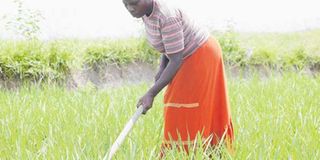New hybrid rice variety raises farmers’ income

Welezo villager Monica Jilabi works at her farm in Shinyanga Region. TXD 3016, Saro 5 hybrid rice variety has hugely improved productivity. PHOTO | courtesy
Shinyanga. Farmers benefit from a modern paddy seed variety as productivity has risen.
Researched by Dakawa Research Institute, TXD 3016, Saro 5 is seen as a solution to many farmers. It is one of Tanzania’s hybrid rice seeds which are getting widely acknowledged for their enhanced productivity. The Walezo area in Shinyanga Rural can be an example of as farmers can produce 28-40 bags per acre if they follow modern farm practices.Major limitations are generally due to the hybrid rice seed technology being laborious and intensive, besides the high cost of the seeds.
However, in Shinyanga, Oxfam and Rural Urban Development Initiatives (Rudi) are making it possible for farmers to get the seeds.
The hybrid rice seeds market growth in developing countries is varying from moderate to stagnant, owing to the lack of trained human resources, lack of sufficient water, and unfavourable climatic conditions.
Rice producing Asian countries, apart from China, which include India, Indonesia, Bangladesh, the Philippines, Vietnam, Myanmar, and Pakistan, together have 4.5 million hectares under hybrid rice seed cultivation.
In African countries such as Liberia, Mozambique, Nigeria, Uganda, Madagascar and Tanzania, cultivation with hybrid rice seeds started in the early 2000s. Walezo Village has a modern warehouse and a rice miller that has added the rice value and made farmers benefit from agriculture.
Middle men no longer exploit farmers. According to researcher Hezron Tusekelege, the seeds were first planted on a sizeable scale in 2002 after a long-term study, and have now spread across the country and neighbouring countries such as Burundi, Rwanda and Kenya.
At the same time the centre also conducts further research to improve the seeds, after discovering birds are eating them.
Farmer Winfrida Mlale said before starting using the modern seed variety, harvests were poor.
But after receiving training from Oxfam and Rudi on modern agriculture and the new seed variety in 2014, farmers began getting high yields.
“I have been getting two or three bags per acre,” she said.
However, after 2014, in her three acres, she built a house and paid school fees for her children.
Seven farmers have established the Shyrice Group to build a warehouse and a modern miller.
Shyrice Group secretary Monica Jilabi said: “We started the project in 2012 by raising money from Vicoba but it didn’t work out until 2014 when Oxfam/Rudi reached our village and trained us on modern agriculture.”
The machine is capable of dehusking between 90 and 120 bags per day.
Farmers pay Sh50 for one kilo of rice to be dehusked.
“Rice value has been increased and more profit earned. Farmers can sell their rice according to grades,” she said. In 2016 the machine dehusked 1,024 kilos of rice. The amount increased in 2017 to 52,010 kilos.
Rudi project manager Stephano Mpangala said rice husks were used to make bricks and farmers would be taught how to make charcoal from them.
According to him, rice leaves are left in field to fertilise the soil as they have no technology to process so that can be used as livestock feeds.
Rice is cultivation in Tanzania is still characterized by low yield and productivity as affected by factors such as lack of irrigation infrastructure, low-yield seeds and outdated farming practices.
Rice farming is also faced by other challenges like poor roads to the market, lack of quality storage facilities and post-harvest losses.
But efforts are mounting to improve production in the agriculture sector which employs over 60 per cent of the working population and generate over 60 per cent of the country’s raw materials.




